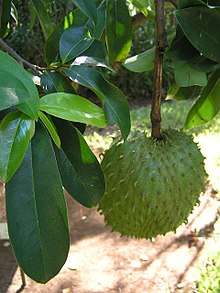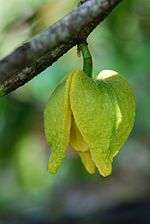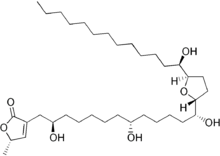Soursop
Soursop (also graviola, guyabano, and in Latin America, guanábana) is the fruit of Annona muricata, a broadleaf, flowering, evergreen tree.[4][5] The exact origin is unknown; it is native to the tropical regions of the Americas and the Caribbean and is widely propagated.[6] It is in the same genus, Annona, as cherimoya and is in the Annonaceae family.
| Soursop | |
|---|---|
 | |
 | |
| Soursop fruit on its tree | |
| Scientific classification | |
| Kingdom: | Plantae |
| Clade: | Tracheophytes |
| Clade: | Angiosperms |
| Clade: | Magnoliids |
| Order: | Magnoliales |
| Family: | Annonaceae |
| Genus: | Annona |
| Species: | A. muricata |
| Binomial name | |
| Annona muricata | |
| Synonyms | |
|
Annona macrocarpa Wercklé | |

The soursop is adapted to areas of high humidity and relatively warm winters; temperatures below 5 °C (41 °F) will cause damage to leaves and small branches, and temperatures below 3 °C (37 °F) can be fatal. The fruit becomes dry and is no longer good for concentrate.
With an aroma similar to pineapple,[5] the flavor of the fruit has been described as a combination of strawberries and apple with sour citrus flavor notes, contrasting with an underlying thick creamy texture reminiscent of banana.
Soursop is widely promoted (sometimes as "graviola") as an alternative cancer treatment, but there is no medical evidence it is effective for treating cancer or any disease.[7]
Annona muricata
Annona muricata is a species of the genus Annona of the custard apple tree family, Annonaceae, which has edible fruit.[4][5] The fruit is usually called soursop due to its slightly acidic taste when ripe. Annona muricata is native to the Caribbean and Central America but is now widely cultivated – and in some areas, becoming invasive – in tropical and subtropical climates throughout the world.[4][5]
Description

Annona muricata is a small, upright, evergreen tree that can grow to about 30 feet (9.1 m) tall.[4][5][8][9]
Its young branches are hairy.[9] Leaves are oblong to oval, 8 centimetres (3.1 in) to 16 centimetres (6.3 in) long and 3 centimetres (1.2 in) to 7 centimetres (2.8 in) wide. They are a glossy dark green with no hairs above, and paler and minutely hairy to no hairs below.[9] The leaf stalks are 4 millimetres (0.16 in) to 13 millimetres (0.51 in) long and without hairs.[9]
Flower stalks (peduncles) are 2 millimetres (0.079 in) to 5 millimetres (0.20 in) long and woody. They appear opposite from the leaves or as an extra from near the leaf stalk, each with one or two flowers, occasionally a third.[9] Stalks for the individual flowers (pedicels) are stout and woody, minutely hairy to hairless and 15 millimetres (0.59 in) to 20 millimetres (0.79 in) with small bractlets nearer to the base which are densely hairy.[9]
The petals are thick and yellowish. Outer petals meet at the edges without overlapping and are broadly ovate, 2.8 centimetres (1.1 in) to 3.3 centimetres (1.3 in) by 2.1 centimetres (0.83 in) to 2.5 centimetres (0.98 in), tapering to a point with a heart shaped base. They are evenly thick, and are covered with long, slender, soft hairs externally and matted finely with soft hairs within. Inner petals are oval shaped and overlap. They measure roughly 2.5 centimetres (0.98 in) to 2.8 centimetres (1.1 in) by 2 centimetres (0.79 in), and are sharply angled and tapering at the base. Margins are comparatively thin, with fine matted soft hairs on both sides. The receptacle is conical and hairy. The stamens are 4.5 millimetres (0.18 in) long and narrowly wedge-shaped. The connective-tip terminate abruptly and anther hollows are unequal. Sepals are quite thick and do not overlap. Carpels are linear and basally growing from one base. The ovaries are covered with dense reddish brown hairs, 1-ovuled, style short and stigma truncate.[9] Its pollen is shed as permanent tetrads.[10]
The fruits are dark green and prickly. They are ovoid and can be up to 30 centimetres (12 in) long,[9] with a moderately firm texture.[6] Their flesh is juicy, acid, whitish[6] and aromatic.[9]
Distribution
Annona muricata is tolerant of poor soil[6] and prefers lowland areas between the altitudes of 0 to 1,200 metres (3,900 ft). It cannot stand frost.[8][9] The exact origin is unknown; it is native to the tropical regions of the Americas and is widely propagated.[4][5][6] It is an introduced species on all temperate continents, especially in subtropical regions.[4][5]
Cultivation
The plant is grown for its 20–30 cm (7.9–11.8 in) long, prickly, green fruit, which can have a mass of up to 6.8 kg (15 lb),[5] making it probably the second biggest annona after the junglesop. Away from its native area, some limited production occurs as far north as southern Florida within USDA Zone 10; however, these are mostly garden plantings for local consumption. It is also grown in parts of Southeast Asia and is abundant on the Island of Mauritius. The main suppliers of the fruit are Mexico followed by Peru, Brazil, Ecuador, Guatemala, and Haiti.[11]

Uses
The flesh of the fruit consists of an edible, white pulp, some fiber, and a core of indigestible black seeds. The pulp is also used to make fruit nectar, smoothies, fruit juice drinks, as well as candies, sorbets, and ice cream flavorings.[4][5] Due to the fruit's widespread cultivation, its derivative products are consumed in many countries like Mexico, Brazil, Venezuela, Colombia[12] and Fiji.[13] The seeds are normally left in the preparation, and removed while consuming, unless a blender is used for processing.
In Indonesia, dodol sirsak, a sweetmeat, is made by boiling soursop pulp in water and adding sugar until the mixture hardens. Soursop is also a common ingredient for making fresh fruit juices that are sold by street food vendors. In the Philippines, it is called guyabano, derived from the Spanish guanábana, and is eaten ripe, or used to make juices, smoothies, or ice cream. Sometimes, they use the leaf in tenderizing meat. In Vietnam, this fruit is called mãng cầu Xiêm (Siamese Soursop) in the south, or mãng cầu (Soursop) in the north, and is used to make smoothies, or eaten as is. In Cambodia, this fruit is called tearb barung, literally "western custard-apple fruit." In Malaysia, it is known in Malay as durian belanda ("Dutch durian") and in East Malaysia, specifically among the Dusun people of Sabah, it is locally known as lampun. Popularly, it is eaten raw when it ripens, or used as one of the ingredients in Ais Kacang or Ais Batu Campur. Usually the fruits are taken from the tree when they mature and left to ripen in a dark corner, whereafter they will be eaten when they are fully ripe. It has a white flower with a very pleasing scent, especially in the morning. While for people in Brunei Darussalam this fruit is popularly known as "Durian Salat", widely available and easily planted.
Subspecies as synonyms
- Annona muricata var. borinquensis[3]
Nutrition
| Nutritional value per 100 g (3.5 oz) | |
|---|---|
| Energy | 276 kJ (66 kcal) |
16.84 g | |
| Sugars | 13.54 g |
| Dietary fiber | 3.3 g |
0.3 g | |
1 g | |
| Vitamins | Quantity %DV† |
| Thiamine (B1) | 6% 0.07 mg |
| Riboflavin (B2) | 4% 0.05 mg |
| Niacin (B3) | 6% 0.9 mg |
| Pantothenic acid (B5) | 5% 0.253 mg |
| Vitamin B6 | 5% 0.059 mg |
| Folate (B9) | 4% 14 μg |
| Choline | 2% 7.6 mg |
| Vitamin C | 25% 20.6 mg |
| Minerals | Quantity %DV† |
| Calcium | 1% 14 mg |
| Iron | 5% 0.6 mg |
| Magnesium | 6% 21 mg |
| Phosphorus | 4% 27 mg |
| Potassium | 6% 278 mg |
| Sodium | 1% 14 mg |
| Zinc | 1% 0.1 mg |
| Other constituents | Quantity |
| Water | 81 g |
| |
| †Percentages are roughly approximated using US recommendations for adults. Source: USDA Nutrient Database | |
Raw soursop is 81% water, 17% carbohydrates, 1% protein, and has negligible fat (table). In a 100 gram reference amount, the raw fruit supplies 66 calories, and contains only vitamin C as a significant amount (25%) of the Daily Value, with no other micronutrients in appreciable amounts (table).
Phytochemicals
The compound annonacin is contained in the fruit, seeds, and leaves of soursop.[14][15][16] The leaves of Annona muricata contain annonamine, which is an aporphine-class alkaloid containing a quaternary ammonium group.[17]
Potential neurotoxicity
The Memorial Sloan-Kettering Cancer Center cautions, "alkaloids extracted from graviola may cause neuronal dysfunction".[15] Annonacin has been shown in laboratory research to be neurotoxic.[15][16][18] In 2010, the French food safety agency, Agence française de sécurité sanitaire des produits de santé, concluded that "it is not possible to confirm that the observed cases of atypical Parkinson syndrome ... are linked to the consumption of Annona muricata".[19]
Bogus cancer treatment
In 2008, the Federal Trade Commission in the United States stated that use of soursop to treat cancer was "bogus", and there was "no credible scientific evidence" that the extract of soursop sold by Bioque Technologies "can prevent, cure, or treat cancer of any kind."[20] Also in 2008, a UK court case relating to the sale of Triamazon, a soursop product, resulted in the criminal conviction of a man under the terms of the UK Cancer Act for offering to treat people for cancer. A spokesman for the council that instigated the action stated, "it is as important now as it ever was that people are protected from those peddling unproven products with spurious claims as to their effects."[21]
The Memorial Sloan-Kettering Cancer Center and Cancer Research UK state that cancer treatment using soursop is not supported by reliable clinical evidence.[7][15] According to Cancer Research UK, "Many sites on the internet advertise and promote graviola capsules as a cancer cure, but none of them are supported by any reputable scientific cancer organisations" and "there is no evidence to show that graviola works as a cure for cancer".[7]
See also
- Annona crassiflora
- Annona reticulata
- Atemoya
- Cherimoya
- List of ineffective cancer treatments
- Sugar-apple
- Pawpaw
References
- "Annona muricata". Germplasm Resources Information Network (GRIN). Agricultural Research Service (ARS), United States Department of Agriculture (USDA). Retrieved 2008-04-18.
- "Plant Name Details Annonaceae Aluguntugui L." International Plant Names Index. International Organization for Plant Information (IOPI). Retrieved 2008-04-18.
- W3TROPICOS. "Annona muricata L." Missouri Botanical Garden Press. Retrieved 2008-04-18.
- "Annona muricata (soursop)". CABI. 3 January 2018. Retrieved 25 May 2018.
- Julia F. Morton (1987). "Soursop, Annona muricata". West Lafayette, IN: New Crop Resource Online Program, Center for New Crops & Plant Products, Department of Horticulture and Landscape Architecture, Purdue University. Retrieved 25 May 2018.
- "Annona muricata L., Annonaceae". Institute of Pacific Islands Forestry: Pacific Island Ecosystems at Risk (PIER). 2008-01-05. Archived from the original on 12 May 2008. Retrieved 2008-04-18.
- "Graviola (soursop)". Cancer Research UK. 22 October 2018. Retrieved 29 December 2019.
- EEB Greenhouse Staff, University of Connecticut (2008-04-10). "Annona muricata L." Ecology & Evolutionary Biology Greenhouses. Ecology & Evolutionary Biology Greenhouses. Retrieved 2008-04-18.
crfg
- "Annona muricata L." eFloras.org. Retrieved 2008-04-18.
- Walker JW (1971) Pollen Morphology, Phytogeography, and Phylogeny of the Annonaceae. Contributions from the Gray Herbarium of Harvard University, 202: 1-130.
- Gordon, André. Food Safety and Quality Systems in Developing Countries. p. 6.
- "Soursop". Retrieved 20 March 2019.
- "Soursop Season". Retrieved 20 March 2019.
- Le Ven, J.; Schmitz-Afonso, I.; Touboul, D.; Buisson, D.; Akagah, B.; Cresteil, T.; Lewin, G.; Champy, P. (2011). "Annonaceae fruits and parkinsonism risk: Metabolisation study of annonacin, a model neurotoxin; evaluation of human exposure". Toxicology Letters. 205: S50–S51. doi:10.1016/j.toxlet.2011.05.197.
- "Graviola". Memorial Sloan-Kettering Cancer Center. 1 February 2017. Retrieved 25 May 2018.
- Potts, Lisa F.; Luzzio, Frederick A.; Smith, Scott C.; Hetman, Michal; Champy, Pierre; Litvan, Irene (2012). "Annonacin in Asimina triloba fruit: Implication for neurotoxicity". NeuroToxicology. 33 (1): 53–58. doi:10.1016/j.neuro.2011.10.009. ISSN 0161-813X. PMID 22130466.
- Matsushige, A; Kotake, Y; Matsunami, K; Otsuka, H; Ohta, S; Takeda, Y (2012). "Annonamine, a new aporphine alkaloid from the leaves of Annona muricata". Chem Pharm Bull. 60 (2): 257–9. doi:10.1248/cpb.60.257. PMID 22293487.
- Lannuzel, A.; Höglinger, G. U.; Champy, P.; Michel, P. P.; Hirsch, E. C.; Ruberg, M. (2006). "Is atypical parkinsonism in the Caribbean caused by the consumption of Annonacae?". Journal of Neural Transmission. Supplemental. Journal of Neural Transmission. Supplementa. 70 (70): 153–7. doi:10.1007/978-3-211-45295-0_24. ISBN 978-3-211-28927-3. PMID 17017523.
- "Avis de l'Agence française de sécurité sanitaire des aliments relatif aux risques liés à la consommation de corossol et de ses préparations" (PDF). Agence française de sécurité sanitaire des aliments. 28 April 2010. Retrieved 1 August 2013.
- "FTC Sweep Stops Peddlers of Bogus Cancer Cures". US Federal Trade Commission. 18 September 2008.
- "Man convicted over cancer 'cure'". BBC News. 10 September 2008.
External links
| Wikimedia Commons has media related to Annona muricata. |

- Soursop, List of Chemicals, Dr. James Duke, USDA Phytochemical and Ethnobotanical Databases, November 2004